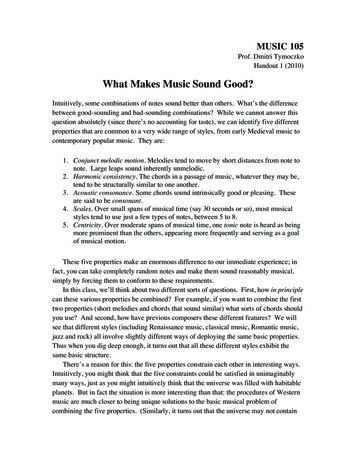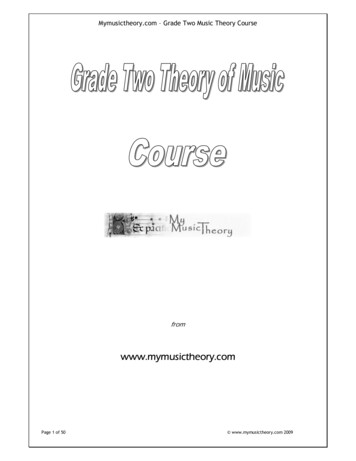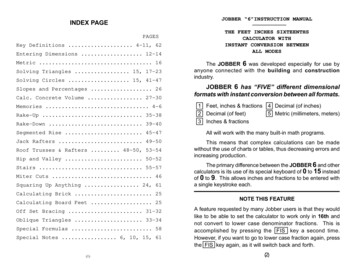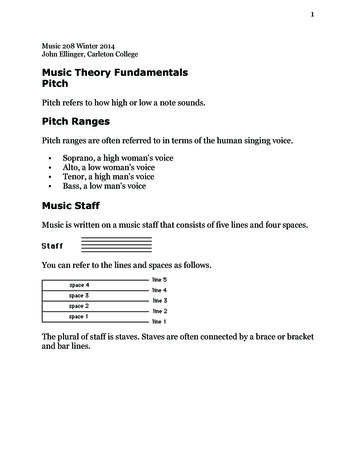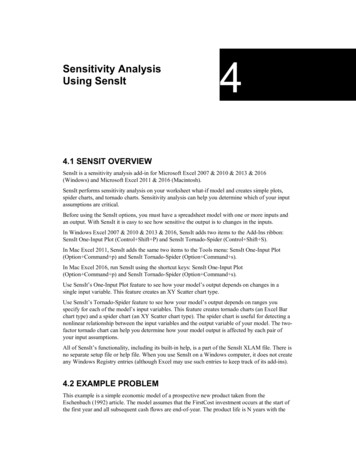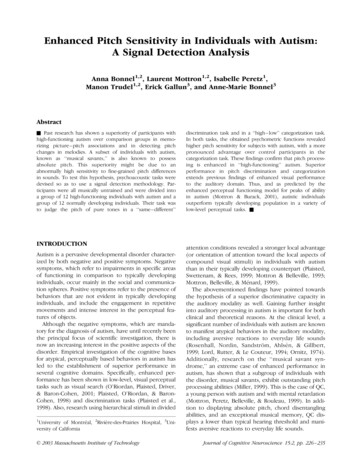
Transcription
Enhanced Pitch Sensitivity in Individuals with Autism:A Signal Detection AnalysisAnna Bonnel1,2, Laurent Mottron1,2, Isabelle Peretz1,Manon Trudel1,2, Erick Gallun3, and Anne-Marie Bonnel3Abstract& Past research has shown a superiority of participants withhigh-functioning autism over comparison groups in memorizing picture – pitch associations and in detecting pitchchanges in melodies. A subset of individuals with autism,known as ‘‘musical savants,’’ is also known to possessabsolute pitch. This superiority might be due to anabnormally high sensitivity to fine-grained pitch differencesin sounds. To test this hypothesis, psychoacoustic tasks weredevised so as to use a signal detection methodology. Participants were all musically untrained and were divided intoa group of 12 high-functioning individuals with autism and agroup of 12 normally developing individuals. Their task wasto judge the pitch of pure tones in a ‘‘same – different’’INTRODUCTIONAutism is a pervasive developmental disorder characterized by both negative and positive symptoms. Negativesymptoms, which refer to impairments in specific areasof functioning in comparison to typically developingindividuals, occur mainly in the social and communication spheres. Positive symptoms refer to the presence ofbehaviors that are not evident in typically developingindividuals, and include the engagement in repetitivemovements and intense interest in the perceptual features of objects.Although the negative symptoms, which are mandatory for the diagnosis of autism, have until recently beenthe principal focus of scientific investigation, there isnow an increasing interest in the positive aspects of thedisorder. Empirical investigation of the cognitive basesfor atypical, perceptually based behaviors in autism hasled to the establishment of superior performance inseveral cognitive domains. Specifically, enhanced performance has been shown in low-level, visual perceptualtasks such as visual search (O’Riordan, Plaisted, Driver,& Baron-Cohen, 2001; Plaisted, O’Riordan, & BaronCohen, 1998) and discrimination tasks (Plaisted et al.,1998). Also, research using hierarchical stimuli in divided1University of Montréal, 2Rivière-des-Prairies Hospital, 3University of CaliforniaD 2003 Massachusetts Institute of Technologydiscrimination task and in a ‘‘high – low’’ categorization task.In both tasks, the obtained psychometric functions revealedhigher pitch sensitivity for subjects with autism, with a morepronounced advantage over control participants in thecategorization task. These findings confirm that pitch processing is enhanced in ‘‘high-functioning’’ autism. Superiorperformance in pitch discrimination and categorizationextends previous findings of enhanced visual performanceto the auditory domain. Thus, and as predicted by theenhanced perceptual functioning model for peaks of abilityin autism (Mottron & Burack, 2001), autistic individualsoutperform typically developing population in a variety oflow-level perceptual tasks. &attention conditions revealed a stronger local advantage(or orientation of attention toward the local aspects ofcompound visual stimuli) in individuals with autismthan in their typically developing counterpart (Plaisted,Swettenam, & Rees, 1999; Mottron & Belleville, 1993;Mottron, Belleville, & Ménard, 1999).The abovementioned findings have pointed towardsthe hypothesis of a superior discriminative capacity inthe auditory modality as well. Gaining further insightinto auditory processing in autism is important for bothclinical and theoretical reasons. At the clinical level, asignificant number of individuals with autism are knownto manifest atypical behaviors in the auditory modality,including aversive reactions to everyday life sounds(Rosenhall, Nordin, Sandström, Ahlsén, & Gillbert,1999; Lord, Rutter, & Le Couteur, 1994; Ornitz, 1974).Additionally, research on the ‘‘musical savant syndrome,’’ an extreme case of enhanced performance inautism, has shown that a subgroup of individuals withthe disorder, musical savants, exhibit outstanding pitchprocessing abilities (Miller, 1999). This is the case of QC,a young person with autism and with mental retardation(Mottron, Peretz, Belleville, & Rouleau, 1999). In addition to displaying absolute pitch, chord disentanglingabilities, and an exceptional musical memory, QC displays a lower than typical hearing threshold and manifests aversive reactions to everyday life sounds.Journal of Cognitive Neuroscience 15:2, pp. 226 – 235
To account for these findings, the enhanced perceptual functioning (EPF) model (Mottron & Burack,2001) proposes that superior pitch processing inautism is one of the manifestations of the overdevelopment of low-level perceptual operations. This modelcontends that information processing systems devotedto the detection, discrimination, and categorization ofperceptual stimuli are enhanced in autism. This shouldresult in superior performance in the abovementionedseries of perceptual tasks. It should also result in an‘‘overextension’’ of perceptual systems beyond theirtypical domain of application. An example of thisoverextension is the use of nonalgorithmic processesby a savant individual with autism in the graphicreproduction of 3-D information, a task that is typically performed by perspective algorithms (Mottron &Belleville, 1995).Enhancement of low-level perceptual processing,from discrimination to categorization, as predicted bythe EPF model, should result in low-level perceptualauditory tasks being performed at a higher level byindividuals with autism relative to comparison participants. In a first study of the perception of complexauditory information in nonsavant individuals withhigh-functioning autism, Mottron, Peretz, and Ménard(2000) assessed differential local and global processingusing a same – different judgment task on pairs ofmelodies. In their experiment, local processing wasassessed by modifying target melodies at the pitchlevel, without contour modification, and global processing by modifying melodies at the contour level andthrough melodic transposition. Results showed thatindividuals with high-functioning autism were superiorto the comparison group at discriminating betweennontransposed, contour-preserved melodies that taplocal musical processing, a finding that is consistentwith an enhanced perception of local pitches in theauditory modality.The finding that individuals with high-functioningautism are better than comparison participants at discriminating between pitches presented in the form ofcompound musical stimuli suggests that they shouldalso excel at discriminating between the frequencies ofpure tones presented in isolation. Superior abilities infrequency discrimination might account for both auditory aversive reactions and for exceptional pitch processing abilities in some savant individuals with autism(Anastasi & Levee, 1960). Moreover, in the same waythat enhanced processing of low-level aspects of information may contribute to a local bias in the visualdomain, enhanced pitch discrimination may contributeto a superior detection of local, pitch modifications inmusical material.The present study assesses pitch ‘‘sensitivity’’ usingsignal detection theory (STD; Green & Swets, 1966/1974). SDT methods allow the separation of two aspectsof an observer’s response. The first of these, called‘‘sensitivity,’’ refers to how well the observer is able tomake correct judgments and to avoid incorrect ones.The second of these, called ‘‘response bias’’ (or decisioncriterion), measures the propensity of an observer tofavor one response over another (e.g., in a discrimination experiment, ‘‘same’’ vs. ‘‘different’’ responses). Assuch, SDT provides a measure of response accuracy thatis independent from response bias.Whereas past research assessed pitch processing inthe framework of hierarchical, local –global models ofprocessing in autism, using compound musical material,the present experiment assesses pitch sensitivity in thecontext of pure tones presented in isolation. To thisend, two types of low-level, auditory processing taskswere selected, discrimination and categorization of puretones varying in frequency and presented at a fixedintensity level. Discrimination and categorization tasksmay require the intervention of different memorymodes and tap different perceptual processes (Bonnel& Hafter, 1998; Durlach & Braida, 1969). In order todiscriminate between two sounds presented in pairs,subjects have to rely on sensory or ‘‘trace’’ memory.This trace lasts only a few seconds and is vulnerable tointerference (Cowan, 1984). In the categorization of asingle sound as high or low in pitch, subjects have torely on a ‘‘context-coding’’ mode (Durlach & Braida,1969). In order to make categorical judgments, subjectsneed to refer to previous trials (Stewart, Brown, &Chater, 2002). That is, subjects have to assess andupdate the pitch value of any given tone in the contextof the preceding tones. This type of task is moredemanding in memory and attention load than thediscrimination task (Bonnel & Hafter, 1998). Accordingly, the categorization task is expected to be moredifficult and to require reliance on a different memorycode than the discrimination task.RESULTSExperiment 1: Pitch DiscriminationCorrelation Between Confidence Ratings, ResponseAccuracy, and Response LatencyIn order to assess whether or not the participants wereable to use confidence ratings coherently, the agreement between confidence levels and response accuracywas examined. The percentage of correct responsesobtained by participants in the task (all levels of difficultycombined) closely matches the confidence ratings categories. Pearson correlations were significant for theclinical group, with r .66 ( p .020), but nonsignificant for the comparison group, r .16 ( p .612).That is, higher confidence responses are significantlyassociated with higher rates of correct responses for theclinical group.Additionally, participants’ response latencies wererelated to their confidence levels. As expected, the lowerBonnel et al.227
the confidence level, the higher the response latency.Pearson correlation were significant for both groupswith r .61 ( p .036) and r .86 ( p .000)for the clinical and comparison group, respectively.Thus, participants’ responses seem to faithfully reflecttheir ability to perform the discrimination task.Figure 2. Psychometric functions: sensitivity index observed for eachgroup in the three conditions of the pitch-discrimination task.Subjects’ Use of Confidence RatingsAn independent-samples t test was conducted to ensure that subjects in both groups used each confidencerating category (i.e., high, middle, and low confidence)to a similar extent. This analysis was conducted withthe three levels of difficulty combined, as well asseparated. In both cases, results revealed no significantdifferences between the clinical and comparison groupson this variable [e.g., for combined levels of difficulty:t(22) .07, p .947)]. These results were alsoconfirmed by Mann – Whitney nonparametric tests.Thus, subjects in both groups made the same use ofthe confidence ratings.Receiver Operating Characteristics (ROC) CurvesFigure 1. ROC curves observed for each group in the three conditionsof the pitch-discrimination task.228Journal of Cognitive NeuroscienceThe ROCs observed for each group in each condition ofthe discrimination task are presented in Figure 1. As canbe seen, the clinical participants exhibit higher ROCs forthe two easiest conditions (3% and 2%). However, themost difficult condition (1%) leads to very similar functions for the two groups.Sensitivity measures. As can be seen in Figure 2, inwhich participants’ performance is expressed in dasensitivity measures, the superiority of the clinicalparticipants in the discrimination task is significant atp .05 for the conditions 2% and 3% and nonsignificant for the 1% condition. The fact that the 1%condition did not yield significant differences may beexplained by a ‘‘data limits,’’ or floor effect, due to theinsufficient amount of information available to thesubject (Norman & Bobrow, 1975).In addition to the above analysis, for each subject, therating scale was collapsed in two categories (same/different or low/high) in order to compute a d0 index as anestimate of sensitivity [d0 Z (Hits) Z (FA)]. TheVolume 15, Number 2
agreement between the da (pooled) and d0 (average)estimates was quite good.Experiment 2: Pitch CategorizationAs expected, we found in Experiment 1 that highfunctioning autistic individuals discriminate frequencyFigure 4. Psychometric functions: sensitivity index observed for eachgroup in the three conditions of the pitch-categorization task.differences between successive tones better than typically developing individuals. The goal of Experiment 2was to test whether this heightened sensitivity to pitchfound in autistic participants would generalize to thecategorization of frequencies as being high or low inpitch in a series of isolated tones.Correlation Between Confidence Ratings, ResponseAccuracy, and Response LatencyPreliminary analyses revealed that response accuracyclosely follows the confidence ratings. Indeed, higherconfidence levels are associated with higher responseaccuracy. However, Pearson correlations were nonsignificant for both groups, with r .33 ( p .300) andr .20 ( p .540) for the clinical and comparisonparticipants, respectively.As for participants’ response latencies, results showedthat, as expected, the lower the confidence level, thehigher the response latency. Pearson correlations weresignificant for the comparison group, with r .64( p .024), but nonsignificant for the clinical group,r .45 ( p .146).Subjects’ Use of Confidence RatingsAn analyses of participants’ use of confidence ratingsyielded similar results as in experiment one, demonstrating that both groups used each of the confidence ratingsin a similar proportion [e.g., for combined levels ofdifficulty: t(22) .22, p .827)].Receiver Operating Characteristics CurvesFigure 3. ROC curves observed for each group in the three conditionsof the pitch-categorization task.The ROC curves observed for each group in eachcondition of the pitch-categorization task are presentedin Figure 3. The ROC curves obtained for the clinicalBonnel et al.229
Figure 5. Sensitivity index observed for each group in the two tasks.group indicate a marked superiority over control participants in each of the three conditions (1%, 2%, and 3%).Sensitivity measures. This superiority is also apparentwhen the participants’ performance is transformed in dasensitivity measures: The clinical participants exhibithigher categorization abilities than normally developingindividuals in all three conditions of the categorizationtask (see Figure 4).Furthermore, whereas normally developing individuals performed significantly better in the discriminationthan in the categorization task ( p .05 for each level ofdifficulty), the clinical participants performed equallywell in the two tasks (see Figure 5).As in Experiment 1, d0 indices were computed in orderto validate the sensitivity estimation: The agreementbetween da and d0 indices was quite good.GENERAL DISCUSSIONThe current study assesses pitch sensitivity of individualswith high-functioning autism in two perceptual tasksinvolving pure tones: pitch discrimination and pitch230Journal of Cognitive Neurosciencecategorization. This study is also the first to apply signaldetection methodology to investigate perceptual performance of individuals with autism. Firstly, and asexpected in regard to differences in task requirements,the normally developing group performed the categorization task more poorly than the discrimination task.A decrement in performance in the categorization task isconsistent with the use of a context-coding mode in thistask. By contrast, the clinical group performed these twotasks at the same level. Secondly, individuals with highfunctioning autism were superior to normally developing individuals in the discrimination task. Thirdly, theclinical group outperformed the comparison group inthe categorization task. In sum, and response bias beingremoved by the use of the signal detection methodology, these findings demonstrate superior ‘‘pitch sensitivity’’ in high-functioning individuals with autism.The identical level of performance of the clinicalgroup in the two tasks suggests that individuals withhigh-functioning autism are less sensitive to differencesin task requirements than comparison participants. Thismay result from the clinical group using a similar, tracetype comparison between the stimulus to be judged andthe trace memory of the previous trial in the two tasks.Using this strategy would be possible due to a moreaccurate, fine-grained representation of pitch, i.e.,a trace memory that is more resistant to the varioustypes of noise (temporal decay, pro- and retroactiveinterference), which affect task performance in thecomparison group. A more robust trace memory wouldexplain both superior discrimination abilities as such,and the capacity of the clinical group to keep using thesame memory system in the context of more demandingconditions, where comparison participants have toswitch to a context-coding type of memory.This enhanced sensitivity in pitch discrimination andcategorization may account for the general observationthat autistic individuals excel at music perceptual tasks.There is increasing evidence that fine-grained pitchdiscrimination is essential for the development of anormal functioning system for music. For example,Peretz et al. (2002) have shown that a degraded pitchperceptual system was associated to a poorly developedmusical system in an adult who was otherwise fullyfunctional and, hence, was qualified as congenitallyamusic. More generally, musical impairments in perception and memory due to the presence of a brain lesionor of a congenital anomaly are systematically associatedwith disorders in pitch-related (as opposed to timerelated) variations (Peretz, 2003). This recurrent findingled the latter author to propose that, although musicprocessing is implemented in multiple interconnectedneural networks, material-specific pitch-related mechanisms are the essential components around whichmusical competence develops in the normal brain.In this perspective, enhanced sensitivity to pitchdifferences would confer a clear advantage in musicalVolume 15, Number 2
proficiency. This appears to be the case of highfunctioning autistic individuals. For example, enhancedpitch sensitivity may contribute to a superior detectionof target pitches embedded in a global musical contour.According to this interpretation, the so-called ‘‘localbias’’ evident in high-functioning individuals with autismin the context of auditory hierarchical material (Mottronet al., 2000) would be due to superior pitch perceptionper se. This represents an alternative explanation to the‘‘weak central coherence’’ (WCC) model for peaks ofabilities in autism (Happé, 1999). This model explainssuperior performance in processing pitch by a locallyoriented perception, itself resulting from a deficit inperceiving global aspects of information (Heaton,Hermelin, & Pring, 1998). An alternative explanationfollowing from the current findings would be that, inthe same way that superior visual discrimination(Plaisted et al., 1999) suggests that ‘‘local’’ bias in visualhierarchical tasks may be related to a superior processing of the elementary characteristics of visual stimuliinvolved in low-level visual perception, ‘‘local’’ bias inauditory hierarchical tasks may be based on superiorpitch sensitivity.Finally, these results may be relevant to the interpretation of the higher incidence of ‘‘absolute pitch’’ inmusical savants with autism, inasmuch as the ability tomemorize a pitch-verbal label association involves finegrained, long-term representations of differential pitches.Superior pitch sensitivity in individuals with autismmay be related to the uneven patterns of cortical evokedrelated potentials associated with the detection of pitchmodifications in autism. Gomot, Giard, Adrien, Barthélémy, and Bruneau (2002) assessed the brain mechanisms involved in the automatic detection of pitchchange in children with autism through the mismatchnegativity (MMN). MMN is a cortical temporal potentialassumed to be generated by a comparison processbetween infrequent auditory input and the memorytrace of the standard sound. Their task involved passivelistening of pure tones differing both in frequency andoddity (standard 1000-Hz sounds vs. deviant 1100-Hzsounds) by individuals with autism and with mentalretardation (mean CA: 6 years 10 months, overall MA:4 years 9 months), and by a CA-matched comparisongroup. Among differences in the MMN of participantswith and without autism, the authors reported a shorterMMN latency and a longer MMN activity in children withautism. They interpreted these findings as resulting froma greater sensitivity to pitch deviancy than in the comparison group, as shorter MMN latencies are recorded forgreater frequency deviations. Gomot et al.’s task cannotbe assimilated to a pitch-discrimination or identificationtask, does not control for the attention status of theparticipants, and compares children of unequal mentalage. However, and in addition to the data presented hereand with the finding of a normal sensory gating inchildren with autism (Kemner, Orange, Verbaten, &Van Engeland, 2002), this finding is consistent with areorganization of pitch processing at a cortical level inindividuals with autism.Taken together with evidence from past research, theresults of the present study are consistent with theenhanced perceptual functioning model of autism. First,the multimodality of perceptual tasks for which asuperior performance is found in autism suggests thatthey result from a similar mechanism. Accordingly,recent findings of superior performance of individualswith high-functioning autism in forming visual categories (Plaisted et al., 1999), of diminished interference inlist learning (Mottron, Belleville, Stip, & Morasse, 1998),of more narrow visual perceptual categories (Mottron,Belleville, & Soulières, 2001), and of more accurate itemdetection in visual search tasks (O’Riordan, 1998;O’Riordan et al., 2001), suggest that superior perceptualtraces may be a cross-domain property in autism. Inconsequence, the explanation of superior performancein the visual modality by a compensation for a deficitoccurring within the same modality (Milne et al., 2002)is less plausible. According to these authors, the visuallocal bias observed in individual with autism resultsfrom the compensation of impaired magnocellular pathway by an overfunctioning of the parvocellular pathway.According to our interpretation, this would rather resultfrom a general mechanism involving enhanced processing of psychophysical properties, independently of themodality involved.Second, the fact that the current study demonstratedsuperior performance in autistic individuals of normalintelligence (as opposed to those with mental retardation) shows that peaks of abilities in pitch perception inautism are not ‘‘relative’’ to otherwise impaired performance but rather are ‘‘absolute’’ peaks of abilities.Remarkably, this is also the case for most of the visualtasks for which a superior performance has been shownin autism. Finally, the variety of tasks for which superiorperformance has been found suggests that superiordiscrimination only (Plaisted, 2001) cannot by itselfexplain the entire set of performance in which individuals with autism exhibit superior performance.The EPF model does not provide an explanation forthis superiority, but points to two types of possiblecausal mechanisms: a compensatory overdevelopmentof low-level operations, because of a deficit in higherorder operations, as suggested by the paradoxicalfacilitation model of Kapur (1996), or an intrinsic modification of the learning properties at the cortical tissuelevel in autism. Recent arguments for the latter proposition arose from the discovery of abnormal spatialorganization and density of cortical cells both in thefrontal cortex (area 9) and in the temporal cortex (areas21 and 22) in autism and Asperger syndrome (Casanova,Buxoeveden, Switala, & Roy, 2002a, 2002b).Finally, an interesting observation that results fromthe present study is that high-functioning individualsBonnel et al.231
Table 1. Characteristics of the Clinical and Control GroupAgeLateralityGlobal IQGroupMSDMSDMSDClinical group17.913.7680.318.75108.0810.22Control group16.582.4135.576.62107.759.09with autism are able to use confidence ratings, thereforeallowing the use of signal detection analysis in a varietyof perceptual tasks in high-functioning autism.Candia, & Elbert, 2001). The two groups were matchedat the group level on chronological age, full-scale IQ(Wechsler, 1981; Wechsler, 1974), and laterality (Oldfield, 1971). No statistical differences were found in at test conducted between the two groups on thesevariables: IQ: t(22) .08; age: t(19) 1.01; laterality:t(12) 1.93.This study was approved by a local ethical committee.The tasks were explained to subjects and their parentswho were asked to sign an informed consent form.Participants were compensated for their participation.Table 1 presents the sociodemographic characteristics ofthe participants.METHODSParticipantsAudiometric Hearing TestHigh-Functioning Autistic GroupAll subjects were assessed with a standard audiometrictesting procedure. Eighty-five percent of the participantstook this audiometric screening test first, as possessingnormal hearing was a prerequisite to their inclusion infollowing experiments. Due to scheduling constraints,the remaining 15% of subjects took the hearing testfollowing Experiments 1 and 2. For these participants,inclusion criteria were thus verified a posteriori.For each participant, the audiometric test and the twoexperiments took place on the same day and wereseparated by a 15-min pause. The audiometric hearingtest was conducted by a professional audiologist (M. T.)in a double-walled, double-room, sound-treated, audiometric test chamber whose ambient noise was inaccordance with norms (ANSI S3.1-1991). Experiments1 and 2 were conducted by the same experimenter(A. B.) in a quiet room.The two experiments—pitch discrimination and categorization—were assigned to the subjects in a counterbalanced order. Because no effect of order wasobserved, the two tasks will be presented separately.Participants were first interviewed regarding any history of repeated ear infections, family history of deafness, or auditory trauma. External auditory conducts andthe eardrum were then examined in search of objects orcerumen and to verify the absence of ventilation tubes,redness, etc. The audiometric screening procedure consisted of presenting pure tones whose intensity rangedbetween 10 to 30 dB hearing level (HL). Tone durationvaried between 1000 and 2000 msec. Interstimulusintervals (ISI) varied between 2000 and 5000 msec toavoid false alarms because of signal expectation effects.These tones were presented at standard octave frequencies (250, 500, 1000, 2000, 4000, and 8000 Hz), and atfive additional frequencies (750, 1062, 1500, 3000, and6000 Hz). The latter were selected to ensure that theparticipants had normal hearing in the range of frequencies used in the experimental tasks. The audiometer, a Madsen Electronics* 0B822 equipped withsupra-auricular TDH 39 headphones, had been calibrated less than a month before the beginning of theTwelve participants with high-functioning autism (11males, 1 female) were randomly recruited from thedatabase of the Rivière-des-Prairies’ specialized clinicfor the diagnosis and assessment of pervasive developmental disorders. DSM-IV (American Psychiatric Association [APA], 1994) diagnoses of autism were obtainedthrough the administration of a standardized interview,the Autism Diagnosis Interview—Revised (ADI-R: Lordet al., 1994) and verified through direct standardizedassessment (ADOS-G: Lord, Rutter, & DiLavore, 1997).Albeit satisfying ADI-R and ADOS-G criteria for autism,3 of the 12 participants were also positive for a DSM-IVdiagnosis of Asperger syndrome, a subgroup of pervasive developmental disorders characterized by normal(or overdeveloped) language abilities. Recruitment ofthe clinical group was blind to the ADI items tappingauditory hypersensitivity (Item 78), unusual sensoryinterests (Item 77), and special abilities in music (Items106 – 111), ensuring that the group under study wasrepresentative vis-à-vis the general population of individuals with autism. All participants with autism werestudents or employed in regular jobs, and were living athome or independently at the time of the study.Normally Developing GroupTwelve normally developing adolescents and youngadults (12 males) of normal intelligence (full-scaleIQ 85: see Table 1) were randomly recruited fromthe clinic’s database for comparison individuals. To beincluded in this experiment, and as assessed by a questionnaire, comparison subjects had to be free of any pastor present neurological or psychiatric disorders, medication, learning disabilities, and family history of autismor other neurodevelopmental and psychiatric disorders.Only participants without musical experience, a fortiori without musical ‘‘special abilities’’ were included inthis study, as musical expertise may produce a local biasin musical processing (Bever & Chiarello, 1977) or acortical overrepresentation of pitch (Pantev, Engelien,232Journal of Cognitive NeuroscienceVolume 15, Number 2
study. The air conduction calibration was in accordancewith the American National Standard Institute norms(ANSI S 3.6-1996).Participants pressed a button each time they heard atone. Auditory thresholds were obtained usi
The present study assesses pitch ''sensitivity'' using signal detection theory (STD; Green & Swets, 1966/ 1974). SDT methods allow the separation of two aspects of an observer's response. The first of these, called ''sensitivity,'' refers to how well the observer is able to make correct judgments and to avoid incorrect ones.






